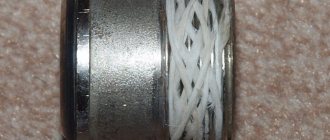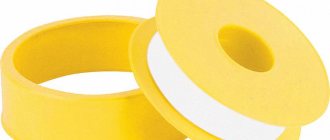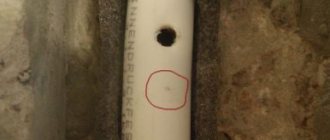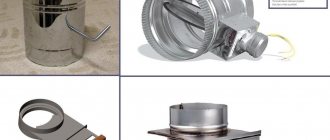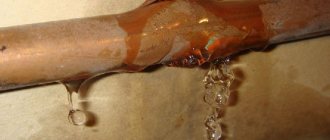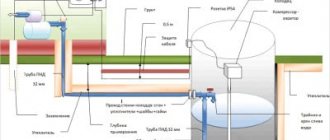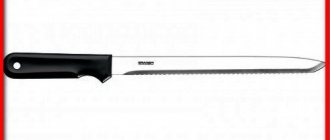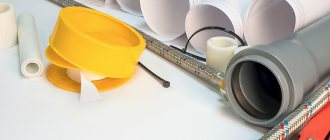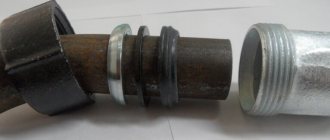How to cut external threads using a die
To cut external threads manually, a special tool is used - a die holder with dies of various diameters.
Die holder with dies for different diameters
In hard-to-reach places, for example near walls, a die holder with a ratchet is used.
Selection of dies
Nominal thread diameter is the diameter at the vertices of the thread triangles. The die cuts the metal, forming depressions and leaving the tops intact, thus both the rod and the die must be the same diameter. The diameter of the thread, for example, is M3 - this is “M” - metric thread, and the number is the nominal diameter of the thread in mm. Accordingly, to cut a thread on a 3 mm rod, we take an M3 die. Measurements of the rod are made with a caliper.
To make the die cut better into the rod, a chamfer is cut off from its end.
Principle of thread cutting with a die
To secure the workpiece you will need a vice. The workpiece is firmly fixed in a vice and lubricated with machine oil for easier movement of the die, reducing friction and tool wear.
When cutting threads with a die, you must avoid large accumulations of chips in the chip removal holes.
The die is installed on the end of the part perpendicularly. With slight pressure, they begin to rotate the die holder clockwise if the thread is right-handed, respectively, if it is left-handed, then counterclockwise.
Cut the thread as follows:
- First make 2-3 turns.
- Then half a turn back to remove chips.
- Lubricate after every 3-4 turns, using a syringe.
- Etc.
I recommend: Collection and delivery of scrap ferrous and non-ferrous metals - how to make money on it
The thread is checked with a nut or ring gauge. You can buy nuts for your thread here → https://rus-metiz.com/categories/gaiki (RusMetiz).
Ring gauge
Cutting a thread with a die with your own hands (video)
Tools
To carry out the work, you need to prepare all the necessary tools and devices for cutting. In each specific case, the pipe thread set will vary in composition, but for manual use it consists of dies, a die and a holder with a ratchet. The kit is also additionally equipped with a pipe cutter, a gas wrench, a file, a hacksaw, an angle grinder, lubricants and other tools. For those who do not want to work the old fashioned way using the classic method, there is an alternative - a power tool.
The cutting itself is carried out using dies. Some are cut on one side only, others on both.
For internal threading, the kit may also include several taps with different slot depths. Some are intended for rough processing of the inner surface of the pipe, others for finishing. This equipment is presented in the form of a screw with chip flutes. It is attached to the gates using the tail part.
Using a tap, internal cutting is carried out in several approaches. Their number depends on the material they are working with. For example, special sets of several taps are designed for threading in titanium alloys.
A die, purlin or hole is used to carve various shapes on pipes. It is a steel nut with a cutting base inside, in which there are special holes - grooves for waste. The dies are tubular, hexagonal, round and square. Modifications of their body can be solid, split and sliding.
Sliding (prismatic) models are also called half-dies; they are attached to the die using screws and a special gasket - a cracker. This is necessary to evenly distribute pressure on the screw. Using dies, cylindrical, conical, round or metric threads are cut. The components of the die are special wrenches and chucks with which it is attached to the frame body.
The die consists of a frame in which the cutting elements - dies - are fixed. Each mandrel is equipped with four steel dies. The Klupp is also equipped with a special ratchet handle. Only one die can be inserted into the die holder, and several into the die holder. The cutting mechanism of the passes is capable of cutting two types of threads: 0.5 - 1 ¼, 1 ½ - 2 inches.
A manual clamp, as a rule, cuts pipes of small diameter. They are equipped with a special handle – holder. They can also be used with a suitable pipe wrench. It is small in size, simple and easy to use.
A socket with a holder and a ratchet is a modification of the design with a gear mechanism designed to carry out threads with a diameter of more than one inch. The ratchet is an indispensable mechanism. With the help of left- and right-handed ratchets, it is convenient to work in hard-to-reach places, for example, near walls. Using the ratchet lever, the die is quickly removed from the thread by twisting in the opposite direction, providing a reciprocating method of thread cutting.
It is called an oblique die because it regulates the distance between the sliding dies. This tells you the cutting diameter. Designs of this type are the easiest to use.
Mayevsky's clamps are of a more complex design and are used for pipe threading. They contain three sets of replacement dies and specialize in thread diameters up to 2 inches. Designs of this type are used for threading pipes with a small diameter.
Cutting on large diameter pipes is carried out on an industrial scale. For example, to cut a seamless pipe with a diameter of 219 mm, a special machine is needed. Casing pipes (columns) are cut only on special machines under special conditions, subject to all safety measures.
Tapping internal threads
Using a tap, cut the internal thread in the pre-drilled hole. The hole should be smaller by approximately the thread size (the thread size is indicated on the tap). Approximately as in the table:
Hole diameter for internal thread with tap
It is worth remembering that the drill will not give an absolutely accurate diameter; it will be larger by a few fractions of a mm. This is especially noticeable on diameters up to 3 mm. This should be taken into account and take a drill less than a tenth of a mm.
Just like with dies, there is a tap holder.
There are rough and finishing taps. Sometimes they cut first with a rough tap, then with a finishing tap, but mostly they use finishing taps straight away.
Manual cutting of internal threads with a tap (video)
The process is almost identical to thread cutting with a die. The tap is attached to the holder and installed perpendicular to the hole. The part with the hole must be securely fastened.
The tap and hole are lubricated and this is done periodically, after several turns. Just like with a die, you need to make 1-2 turns and 0.5 turns back to remove chips.
To check the accuracy of thread cutting, use a square, checking the verticality of the tap after several turns.
Basic cutting methods
You can cut threads on pipes in one of two ways:
- automatic - on machines, power tools;
- manually - using hand tools.
For living conditions, of course, manual technology is more relevant. Cutting threads on water pipes or other pipes by hand is often done using a die.
A die is a simple device for cutting threads on pipes at home. The same tool is successfully used on industrial machines.
The device looks like a disk with several axial holes drilled along its inner diameter. The edges of these holes form several incisors (usually 8-10). The material for the dies is alloy steel or other hard alloys.
There are several types of such devices:
- solid;
- spring-loaded (split);
- clamp (sliding).
According to the design, the die is produced in the form of a circle, square, hexagon, or prism. The most common are disc (round) instruments. They are used for threading water pipes up to a diameter of 36 mm.
For ease of working with dies, use:
- simple knobs with locking screws - hand tools;
- threading chucks on lathes.
Cutting threads (metric, conical) of the best quality on pipes manually or on machines is provided by solid dies.
However, this type of tool, due to the rigidity of its own design, has its negative sides. The cutters wear out quickly.
Spring-loaded (split) dies have a less rigid design, which makes it possible to cut threads on pipes and at the same time change the thread diameter in the range of 0.1-0.3 mm.
Such devices are characterized by increased wear resistance of the cutters, but do not provide high accuracy and cleanliness of thread cutting.
Sliding dies consist of two working parts. They are designed for installation in a fastening module - a clamp.
Fastening in the clamp is carried out by a mechanism consisting of a cracker and an adjusting screw. The screw adjusts the diameter size for thread cutting. Usually the die is equipped with a set of dies for several different diameters.
Method #1 - making pipe threads with dies
The process of creating a thread on a pipe with a die or die requires the mechanic to perform some preliminary actions:
- The surface of the pipe in the cutting area must be thoroughly cleaned.
- The end part of the pipe should be processed with a file (make an entrance chamfer).
- Apply lubricant to the surface to be treated to reduce resistance.
DIY thread cutting on a metal pipe
When installing metal pipes for water supply or heating, they have to be threaded. The threaded connection of pipes is quite reliable and can withstand significant pressure (if done correctly), so let's look at how to cut threads on metal. pipe with your own hands.
First of all, we cut off the required section using a grinder or a hacksaw, making sure to control the evenness of the cut so that one part of the pipe is not larger than the other - the cut must be perpendicular to the walls of the pipe.
The pipe must be cleaned of rust, old paint, etc., if there is anything on it. Next, we cut a chamfer from the pipe (internal or external, depending on what thread you are cutting) for easier movement of the cutting tool. The chamfer can be cut with a grinder with a metal disc (→ how to work with a grinder) or with a flap disk or file.
Beveled metal pipes
Cutting external threads on a pipe using a die (die)
Everything is the same as with the rods described above, but now with a larger diameter, which most likely will require some practice and you should practice or be extremely careful the first time. Also, to obtain high-quality threads and subsequent good pipe connections, you need to work first with a rough die, then with a finishing die (such kits are sold).
I recommend: Basics of metalworking at home: making a clamp and crowbar-nail puller with your own hands
The choice of die metal is also important. To work with hard alloys, you should use the appropriate dies made of certain alloys; please check this when purchasing.
But, a die is not such a good and powerful tool for cutting threads on pipes with your own hands; it is much more convenient to use clamps.
The die holder is practically the same die holder, only with a guide for smooth movement and thread cutting. The clamp is placed on the pipe of this particular guide.
We put on and attach the clamp to the pipe, screwing it in a little by hand, then you need to use either a special tool - a ratchet, which is convenient for twisting the clamp, but for household needs a large adjustable wrench or gas wrench is also suitable.
One part of the pipe must, of course, be fixed in a vice. If the pipe is cut locally, then make sure that it is not torn out somewhere due to the force applied to the clamp. The pipe can be fixed using a second gas wrench, but it is better for a second person to do this, because cutting threads with one hand is problematic.
What is a clamp and how to use it (video)
Cutting internal threads on a pipe with a tap
Sometimes you have to cut into meth. pipes and internal threads. This is done in the same way using a tap, only with a larger diameter.
To cut a good thread, you should use at least 2 taps - roughing and finishing. It is important to select the correct tap for the pipe diameter. So, the internal diameter of the pipe should be larger by the length of the tap turn (more precisely, by the thickness of the cut), this is indicated on the tap itself.
Cutting is done first with one tap, then with a second.
The main thing is to strictly observe the perpendicularity of the tap stroke and control it. That's all, good luck with your threading! Leave your tips and comments below. Subscribe to our newsletter. Good luck to you and good luck to your family!
Preparing to Carve by Hand
Threading pipes at home can be done using available tools. The basic rules of preparation are as follows:
- At the place where the coils are cut, dirt, rust and other contaminants are removed. This recommendation is due to the fact that foreign elements can degrade the quality of the turns.
- If there is a chamfer on the pipe, it is carefully removed using a file. In some cases, this process is carried out with a grinder, but the quality of the resulting chamfer may be low. Therefore, if there is no need to rush, then it is best to carry out the work with a file.
- At the time of work, the surface should be well lubricated with oil. Only in this case can the smooth running of the mechanism used be ensured.
Cutting process
If you do not follow the above recommendations regarding the preparatory stage, the working part can quickly wear out, and the process itself becomes more complicated. In some cases, strong impact can lead to pipe failure.
Conclusions and useful video on the topic
All the nuances of cutting pipe threads in one video:
Knowledge about the creation, operation, and maintenance of threaded connections on pipes is always relevant for every person who deals with housekeeping, plumbing, and other utilities..
Without this information, it is impossible to carry out quality repairs, modernize pipeline systems, or simply maintain the operation of household economic systems.
Do you have anything to add or have questions about cutting threads on pipes? Please leave comments on the publication and suggest your own methods and effective tools for creating carvings. The contact form is located in the lower block.
Source
